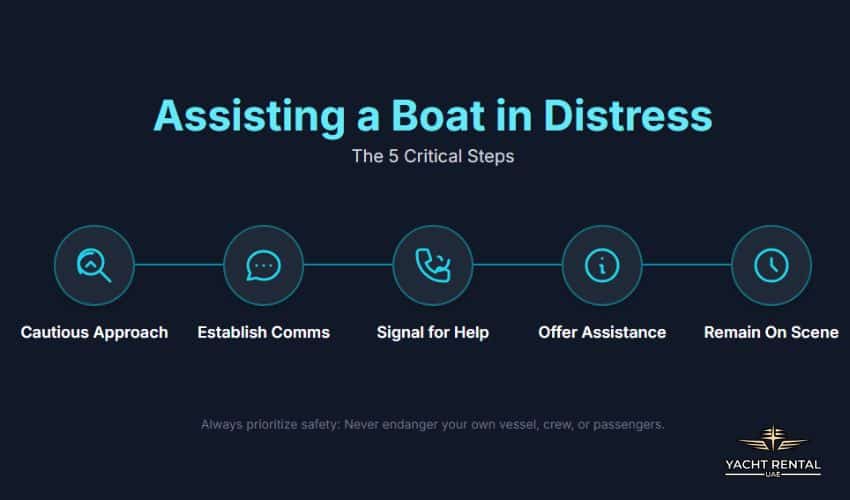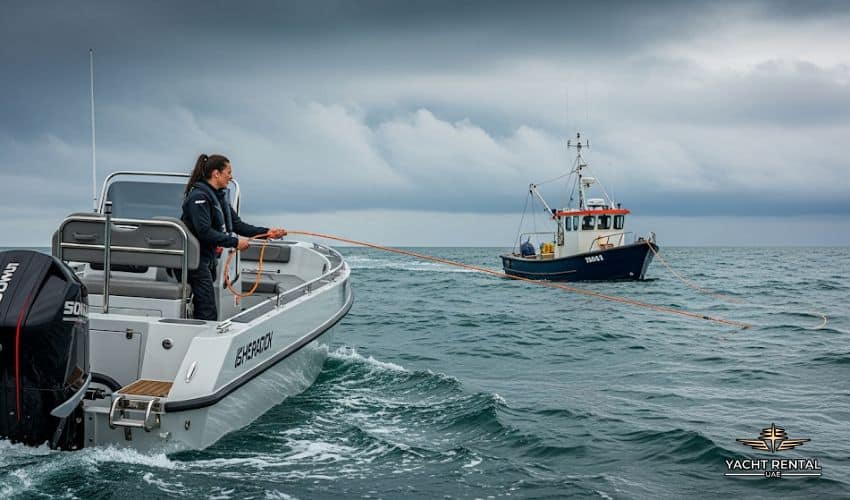Primary Responsibility for a Vessel Operator Assisting a Boat in Distress
As a vessel operator, the sight of another boat in distress triggers a fundamental maritime tradition: the duty to assist. But what does this responsibility truly entail? This critical situation is about more than just good intentions; it involves a careful balance of legal obligations, situational awareness, and an overriding commitment to safety.
The primary responsibility of a vessel operator assisting a boat in distress is to render aid to the extent possible without endangering their own vessel, crew, or passengers. This core principle guides every decision, from the initial approach to the moment professional help arrives.
The Legal and Ethical Duty to Assist: What the Law Says
Before discussing the practical steps, it is important to understand the legal framework. The duty to assist is not just a moral code; it is codified in both U.S. and international maritime law.
A vessel operator’s duty to assist is legally mandated by both national and international law. In the United States, federal code (46 U.S.C. 2304) places a clear responsibility on a vessel’s captain to help anyone found in danger at sea, provided the rescue can be performed without seriously jeopardizing their own vessel and crew.
Also, this principle is mirrored globally by the International Convention for the Safety of Life at Sea (SOLAS), which compels a ship’s master, upon learning of a distress situation, to proceed with maximum speed to render aid. Together, these regulations form the legal backbone of the maritime duty to rescue.
The “Good Samaritan” Protection: To encourage assistance, maritime law includes “Good Samaritan” provisions. These laws generally protect individuals who provide reasonable assistance from liability if something unintentionally goes wrong during the rescue attempt. The key is to act prudently and not with gross negligence.
The 5 Primary Responsibilities in an Assistance Situation

Think of an emergency situation as a sequence of deliberate actions. Rushing in without a plan can create more danger. Follow these five steps to manage the situation safely.
Step 1: The Cautious Approach: First, Do No Harm
Your first priority is to assess the scene from a safe distance. A reckless approach can worsen the situation by creating wakes, causing a collision, or entangling lines.
- Slow Down Immediately: Cut your speed well before you get close. Approach at the slowest controllable speed to minimize your wake.
- Assess the Environment: Analyze the wind, current, and sea state. Plan your approach from downwind or down-current if possible. It prevents you from being pushed onto the distressed vessel and gives you better control.
- Maintain a Safe Distance: Initially, keep a distance of several boat lengths. Use binoculars to evaluate the situation. Are there lines in the water? Is there a fire risk? Are people in the water?
- Ensure Your Own Safety: Confirm your own vessel is secure and your crew knows their roles. Have them don life jackets as a precaution.
Step 2: Establish Communication: The Lifeline of a Rescue
Clear communication is essential for understanding the emergency and coordinating your efforts.
- Use Your VHF Radio: Immediately try to contact the distressed vessel on VHF Channel 16, the international distress and hailing frequency. If you hear a Mayday call, listen carefully and be prepared to relay it if the Coast Guard doesn’t respond.
- Gather Critical Information: Ask clear, direct questions:
- “What is the nature of your distress?” (Sinking, fire, medical, out of fuel, etc.)
- “How many people are on board (P.O.B.)?”
- “Are there any injuries?”
- “What is your position?” (Ask for GPS coordinates).
- “Is the vessel taking on water?”
- Use Visual Signals: If radio contact fails, use recognized visual signals. Waving arms is a universal distress signal. At night, use a flashlight or flares if necessary, and only do so if it is safe to do so.
Step 3: Signal for Professional Help: You Are Not Alone
Unless the situation is minor (e.g., a simple tow in calm water), you should immediately ensure professional rescue services are notified.
- Contact the Coast Guard: Use your VHF radio to contact the Coast Guard or local maritime authorities. If you can’t reach them directly, declare a Mayday Relay. State “Mayday Relay, Mayday Relay, Mayday Relay,” followed by the exact message you heard from the distressed vessel.
- Provide a Clear Report: Give the authorities a complete picture:
- Your vessel’s name and location.
- The distressed vessel’s location, description, and name.
- The nature of the emergency.
- The number of people on board and their condition.
- The on-scene weather conditions.
- Activate Emergency Beacons: If the situation is dire and you have not made contact, advise the distressed vessel to activate its Emergency Position-Indicating Radio Beacon (EPIRB) or Personal Locator Beacon (PLB).
Step 4: Offer Assistance Within Your Capabilities
Once help is on the way, you can offer direct assistance, but only within the safe limits of your vessel, your equipment, and your experience.
- Life-Saving First: If people are in the water, your first priority is getting them out. A Throwable Flotation Device (Type IV PFD) is the safest tool. Throw it to the person; do not encourage them to swim to your boat unless absolutely necessary, and always use a recovery method that minimizes risk, such as a Lifesling.
- Providing Supplies: You may be able to provide life jackets, a first-aid kit, water, a bucket for bailing, or a fire extinguisher. Pass these items over using a line to avoid a close-quarters collision.
- Towing (with Extreme Caution): Towing is a dangerous operation that requires specialized equipment and expertise. Do not attempt a tow unless you are experienced and have the proper gear (e.g., a tow bridle or stout lines). An improper tow can damage both vessels and part lines with dangerous force. Often, the best course of action is to wait for a professional tow service.
Step 5: Remain On Scene Until Relieved
Your responsibility does not end once you have called for help. Staying on scene is a critical part of the rescue.
- Monitor the Situation: Keep a safe distance but remain close enough to observe and offer support.
- Reassure and Communicate: Continue talking to the distressed crew. Keep them calm and informed. You are their link to safety and a source of reassurance.
- Assist Rescue Services: When help arrives (e.g., Coast Guard, Sea Tow), follow their instructions precisely. Provide them with updates and be prepared to assist in their maneuvers if requested.
- Do Not Leave: Only leave the scene after the Coast Guard or another authority has formally taken over the situation and released you.
What NOT to Do: Avoiding Common Mistakes

- DO NOT come alongside a vessel in rough seas. This is a primary cause of injury and damage.
- DO NOT attempt a rescue that is beyond your skill level or your vessel’s capabilities.
- DO NOT jump into the water to rescue someone. This creates a second victim. Always use a throwable device.
- DO NOT hesitate to call for help. Pride has no place in a maritime emergency.
Also Read: You are Caught in a Severe Storm in Your Boat. What Should You Do
Frequently Asked Questions (FAQ)
Q: Am I legally required to help a boat in distress?
A: Yes. U.S. and international law require you to render assistance so long as you can do so without seriously endangering your own vessel or the people aboard.
Q: Can I be sued if I try to help and something goes wrong?
A: You are generally protected by “Good Samaritan” laws, provided you acted in a reasonable and prudent manner and did not cause harm through gross negligence. The law wants to encourage, not punish, assistance.
Q: What is the single most important thing to do?
A: Contact the Coast Guard or other professional rescue service. You are a first responder, not the entire rescue mission. Your most powerful tool is your radio.
Final Words: Be Prepared, Be Prudent, Be the Help They Need
The primary responsibility of a vessel operator is to be a safe and effective link in the chain of survival. When you approach with caution, communicate clearly, signal for professional help, and offer assistance only within your capabilities, you fulfill your legal duty and the highest traditions of the sea. Your calm, deliberate actions can turn a potential tragedy into a successful rescue.







